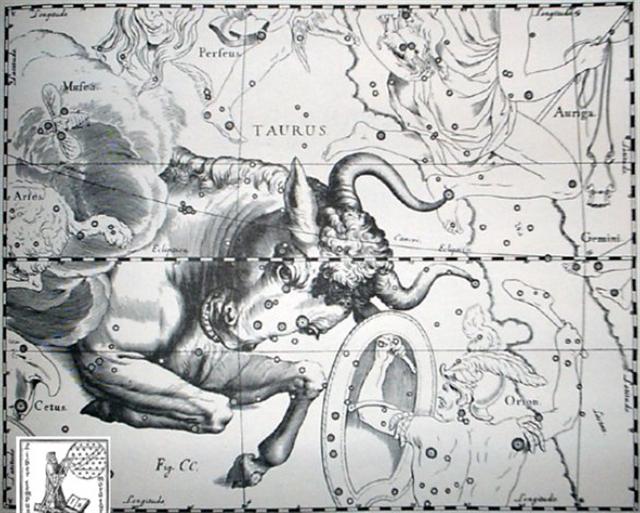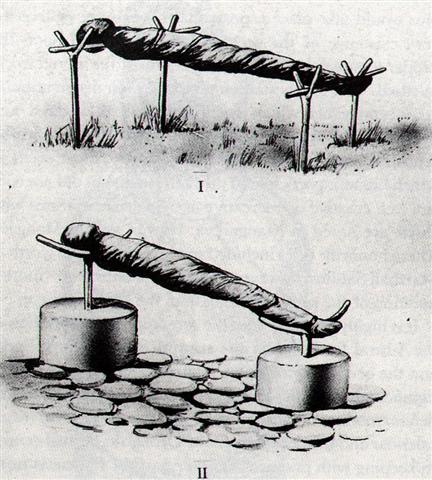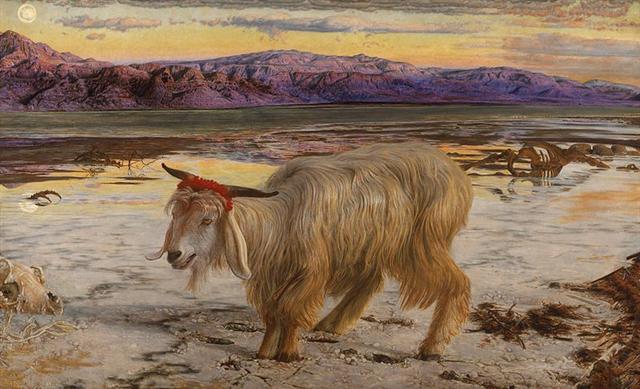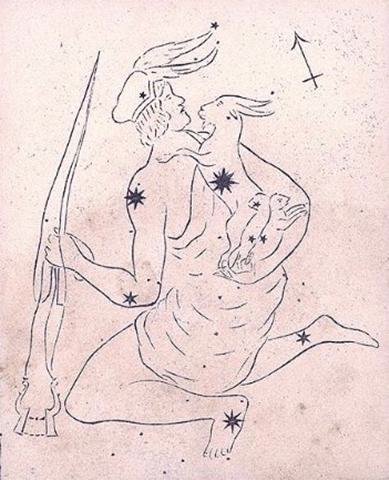Line Cb2 is beginning 4
days before the heliacal
rising of the Pleiades (Tau-ono,
Krittikā):
|
Alrescha 10
(360) |
11 |
12 |
| May 11 |
12 (132) |
13 |
 |
 |
 |
|
Cb2-1 |
Cb2-2 |
Cb2-3 |
| Eaha te honu kua
tupu |
i to maitaki - o te
hau tea |
te hono [sic!]
huki - maro |
|
ξ Tauri
(50.8) |
no stars
listed |
| |
3. Krittikā |
|
|
|
Alrescha 13 |
14 |
15 (365) |
Sheratan 1 |
|
May 14 |
15 |
16 (136) |
17 |
 |
 |
 |
 |
|
Cb2-4 |
Cb2-5 |
Cb2-6 |
Cb2-7 |
| te ua |
koia ra |
kua
tuku ki to mata - ki tona tukuga |
e kiore
- henua - pa rei |
|
no star
listed |
Atiks, Rana
(55.1),
Celaeno, Electra, Taygeta (55.3) |
Maia,
Asterope, Merope (55.6),
Alcyone (56.1), Pleione, Atlas (56.3) |
no star
listed |
|
1 |
Ashvini |
β and γ
Arietis |
Horse's head |
27 |
|
wife of the
Ashvins |
Sheratan and
Mesarthim |
April 17 |
|
2 |
Bharani |
35, 39, and
41 Arietis |
Yoni, the
female organ of reproduction |
41 = 27
+ 14 |
|
the bearer |
Musca
Borealis |
May 1 |
|
3 |
Krittikā |
M 45 Tauri |
Knife or
spear |
55 = 41
+ 14 |
|
the nurses
of Kārttikeya |
The Pleiades |
May 15 |
|
4 |
Rohini |
α Tauri |
Cart or
chariot, temple, banyan tree |
68 = 55
+ 13 |
|
the red one |
Aldebaran |
May 28 |
The 3rd Hindu lunar station Krittikā is
ruled by the Pleiades and like a knife this asterism cuts
through time
creating a before and an after. Or maybe like an egg tooth for
the
chicken to emerge from inside his black confinement:
Tagata in Cb2-5 is 135 (= 5 * 27) days
after December 31 and 55 (= 5 * 11) days after March 21.
Counted from the beginning of the 1st Hindu
station Ashvini, which coincides with Cb1-1--2, there are
135 (May 15) - 107 (April 17) = 28 nights, half of them for
Ashvini and half for Bharani. From May 15 to May 28, however, there are 13
nights. The 4th Hindu station is ruled by Aldebaran and time
is no longer counted in fortnights.
In May 22 there is a great raaraa
('no Sun') glyph and darkness rules before the right eye (Ain) of Taurus
breaks through the morning fogs, before Sun has gone through
the 'gate' of Hyadum I and Hyadum II:
|
Sheratan 2 |
3 |
4 |
|
May 18 |
19 |
20
(140) |
 |
 |
 |
|
Cb2-8 |
Cb2-9 |
Cb2-10 |
|
Niu |
moe te goe |
|
Menkhib (57.6) |
Zaurak (58.9), λ Tauri (59.3) |
ν
Tauri (59.9) |
|
November 18 |
19 |
20
(324) |
|
Syrma 3 |
4 |
5
(188) |
|
Dschubba (241.7), η
Lupi (241.9), υ Herculis (242.3), ρ Cor.
Borealis (242.4), ι Cor. Borealis (242.5) |
ξ Scorpii (242.7),
Acrab, Jabhat al Akrab (243.3), θ Lupi,
Rutilicus (243.5) |
16h
(243.5) |
|
Marfik Herculis
(243.7), φ Herculis (243.8) |
|
Sheratan 5 |
6 |
7 |
|
May
21 |
22 |
23 |
 |
 |
 |
|
Cb2-11 |
Cb2-12 |
Cb2-13 |
|
ka moe i roto |
te henua |
ihe manu ra |
|
4h
(60.9) |
Beid
(62.2) |
Hyadum I (63.4) |
|
no
star listed |
|
November 21 (325) |
22 |
23 |
|
Syrma 6 |
7
(190) |
8 |
|
ψ Scorpii (244.6),
Lesath (244.8), χ Scorpii (245.1), Yed Prior
(245.5) |
no star listed |
Yed Posterior,
Rukbalgethi Shemali (246.6). ο Scorpii (246.8),
σ Scorpii (247.0), Hejian (247.2) |

|
Sheratan 8 |
9 |
10 |
|
May
24 |
25 (145) |
26 |
 |
 |
 |
|
Cb2-14 |
Cb2-15 |
Cb2-16 |
|
kua pua to hau |
te kahi huga |
kiore - henua |
|
Hyadum II (64.2) |
no
star listed |
θ²
Tauri,
Ain,
θ¹ Tauri (65.7) |
|
November 24 |
25 (329) |
26 |
|
Syrma 9 (192) |
10 |
11 |
|
ψ Ophiuchi (247.7),
ρ Ophiuchi (248.1), Kajam (248.3), χ Ophiuchi
(248.5) |
She Low (248.7),
Antares (249.1),
Marfik Ophiuchi, φ Ophiuchi (249.5) |
ω Ophiuchi (249.8),
σ Herculis (250.3) |
... In the beginning were Rangi
and Papa, Sky and Earth. Darkness existed.
Rangi adhered over Papa his wife. Man was
not. A person arose, a spirit who had no
origin; his name was Rangitokona, the
Heaven-propper. He went to Rangi and Papa,
bid them go apart, but they would not. Therefore
Rangitokona separated Rangi and Papa,
he thrust the sky above. He thrust him with his
pillars ten in number end to end; they reached up to
the Fixed-place-of-the-Heavens.
After this separation Rangi
lamented for his wife: and his tears are the dew and
the rain which ever fall on her. This was the chant
that did the work:
Rangitokona, prop up the
heaven! // Rangitokona, prop up the morning!
// The pillar stands in the empty space.
The thought [memea] stands in
the earth-world - // Thought stands also in the sky.
The kahi stands in the
earth-world - // Kahi stands also in the sky.
The pillar stands, the pillar - // It
ever stands, the pillar of the sky.
Then for the first time was there
light between the Sky and the Earth; the world
existed ...
|
Kahi
Tuna; two
sorts:
kahi aveave,
kahi
matamata.
Vanaga.
Mgv.:
kahi, to
run, to
flow. Mq.:
kahi,
id.
Churchill. |
| Hu
1. Breaking of wind. T Mgv., uu, to break wind. Mq., Ta.: hu, id. 2. Whistling of the wind, to blow, tempest, high wind. P Pau.: huga, a hurricane. Churchill.
Mgv.: hu, to burst, to crackle, to snap. Ha.: hu, a noise. Churchill. |
The left eye of Taurus is Aldebaran (Ana-muri)
and the toga signs indicate 'the end station' (down
in the southwest). Aldebaran ('the Follower') represents
the 'old dead bird' (the 'follower' in relation to the
front side of the year). 150 (May 30) = 360 * 5 /
12:
| |
4.
Rohini |
|
|
Sheratan 11 |
12 |
13 |
14 |
|
May
27 |
28 |
29 |
30
(150) |
 |
 |
 |
 |
|
Cb2-17 |
Cb2-18 |
Cb2-19 |
Cb2-20 |
|
manu rere - toga |
manu |
toga |
ka tuu te toga
o te manu |
|
no
star listed |
Aldebaran (68.2),
Theemin (68.5) |
no
stars listed |
|
November 27 |
28
(332) |
29 |
30 |
|
Syrma 12 |
13
(196) |
Az
Zubana 1 |
2 |
|
τ Scorpii (250.7),
Han (251.0) |
ζ Herculis (252.1),
η Herculis (252.5) |
no star listed |
Wei, η Arae (254.3) |

|
Toga
1. Winter season. Two seasons
used to be distinguished in ancient times:
hora, summer, and toga, winter. 2. To
lean against somehing; to hold something fast;
support, post supporting the roof. 3. To throw
something with a sudden movement. 4. To feed
oneself, to eat enough; e-toga koe ana oho ki
te aga, eat well first when you go to work.
Vanaga.
1. Winter. P Pau., Mgv.:
toga, south. Mq.: tuatoka, east wind.
Ta.: toa, south. 2. Column, prop;
togatoga, prop, stay. Togariki,
northeast wind. Churchill.
Wooden platform for a dead
chief: ka tuu i te toga (Bb8-42), when
the wooden platform has been erected. Barthel 2.
The expressions Tonga,
Kona, Toa (Sam., Haw., Tah.), to
indicate the quarter of an island or of the
wind, between the south and west, and Tokelau,
Toerau, Koolau (Sam., Haw., Tah.),
to indicate the opposite directions from north
to east - expressions universal throughout
Polynesia, and but little modified by subsequent
local circumstances - point strongly to a former
habitat in lands where the regular monsoons
prevailed. Etymologically 'Tonga', 'Kona',
contracted from 'To-anga' or 'Ko-ana',
signifies 'the setting', seil. of the sun. 'Toke-lau',
of which the other forms are merely dialectical
variations, signifies 'the cold, chilly sea'.
Fornander. |
From May 28, where the 4th Hindu station
Rohini is beginning, there are 8 days to Cb3-1,
but apparently the last 5 of them may have been - according to
Metoro - tapu nights:
|
Pleione 1 (15) |
2 |
3 |
|
May
31 (151) |
June
1 |
2 |
 |
 |
 |
|
Cb2-21 |
Cb2-22 |
Cb2-23 |
|
kua tapu
- no te manu |
ku kikiu - i te henua |
koia ra |
|
no
stars listed |
|
December 1 |
2
(336) |
3 |
|
Az
Zubana 3 |
4 (200) |
5 |
|
Denebakrab (254.7),
ι Ophiuchi (255.3), Grafias (255.4) |
κ Ophiuchi (256.2) |
Cujam (256.9) |
|
Pleione 4 |
5 (19) |
|
June 3 |
4 (155) |
 |
 |
|
Cb2-24 |
Cb2-25 |
|
tagata tua ivi - te henua |
tagata tua ivi - ki te henua |
|
Hassaleh (73.6) |
Almaaz (74.7), Haedus I (74.8) |
|
December 4 |
5 |
|
Az Zubana 6 |
7 |
|
no star
listed |
17h (258.7) |
|
no star listed |
In early June Sun reached the Auriga
constellation on the northwestern bank of the Milky
Way and the time of the 'Winter Goat' was in the
past. He must be driven away:

Although north of the
equator this was only in
mythical time - because
precession had moved
Auriga ahead in the year
from early March to
early June - the seasons
in central Polynesia
were in harmony with
Auriga as a Sign of the
beginning of a new
'front side':
|
Tahiti |
March - September |
pa-uru
|
|
October - February |
? |
|
Samoa |
April - September |
toe lau |
|
October - March |
vaipalolo |
|
Samoa |
May - October |
dry season |
|
November - April |
wet season |
The Auriga constellation depicts a
man sitting down (because legs characterize
the 2nd half of the year) with an old goat climbing
on his back (meaning the 5 months of the 'old goat'
are in the past):


The pair Cb2-24--25 coincided with (ι,
Hassaleh), Almaaz (ε), and Haedus I (ζ), the right
foot respectively the pair of goat kids. The old goat is the
brilliant Capella ('Goat').
The
constellation is rising up from the Milky River,
with young kids and old goat still inside its
'water':
.jpg)
 |
 |
|
Hassaleh (73.6) |
Almaaz (74.7), Haedus I (74.8) |
Possibly the strange backs
of the figures who are sitting down refer to the standard representation of the
constellation which is enhancing the back side of
the Charioteer.

|























.jpg)
